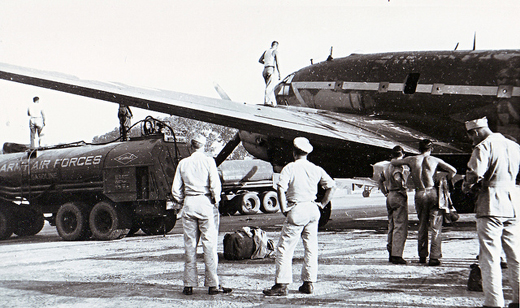Air Operations, Aleutians
3 28th Composite Bomb Group B-24s are forced to abort their mission to reconnoiter and attack Kiska because of bad weather.
[Air Operations, Europe
200 Spitfires carry out an offensive sweep over northern France. Wing Commander 'Paddy' Finucane, a 21-year-old ace with 32 victories, is shot down and killed by machine-gun fire near Le Touquet.
[Air Operations, Libya
During the night, USAFMEAF B-24s attack port facilities and shipping at Benghazi.
[Allied Planning
Plans are prepared for Operation PROVIDENCE, the occupation of Buna by the Allies. Buna is on the north coast of New Guinea.
[Argentina
Ex-President Dr Jaime Ortiz dies at the age of 55.
[Battle of the Atlantic
The German submarine U-576 attacks Convoy KS-520 torpedoing the US bulk carrier Chilore (8310t) about 20 miles west of Okracoke Inlet, North Carolina as well as the Panamanian freigher J. A. Mowinkel (11,147t) and the Nicaraguan merchantman Bluefield (2063t). Chilore later enters a US minefield hitting 2 mines and receiving further damage.
U-576 is sunk by naval land-based aircraft (VS-9) and the US merchant vessel Unicoi off the coast of North Carolina.
| Class | Type VIIC |
| CO | Kapitänleutnant Hans-Dieter Heinecke |
| Location | Atlantic, off Cape Hatteras |
| Cause | Gunfire/ramming |
| Casualties | 45 |
| Survivors | None |
Convoy Ship on Fire after Torpedo Hit |
 |
Brazil, Home Front
Gasoline rationing is introduced.
[China
The air lift from India to China, the first supplies flown 'Over the Hump', operated by Gen Chennault's daring pilots, begins to reach Chiang Kai-shek's forces.
Flying Over the Hump |
 |
Eastern Front
Russian news bulletins admit the loss of Boguchar and Millerovo. While the German Army Group A pushes on quickly towards Rostov, the 1st Panzer Army and 4th Panzer Army reach Kamensk on the Donetz.
SOUTHERN SECTORKamensk and Millerovo are given up as the South Front pulls back.
GERMAN COMMANDInterfering in the operations of the field armies, Hitler sacks von Bock from command of Army Group B, charging him with not attacking with enough vigor and failing to ensure the adequate supply of his units. Weichs takes command of the army group, leaving the 2nd Army under Gen Salmuth.
[ SS Gloucester Castle Sunk by German Auxiliary Cruiser |
 |
Gulf of Mexico
The US tanker Pennsylvania Sun (11,394t) is torpedoed by U-571 about 125 miles west of Key West, Florida. The crew and the Armed Guard abandon the ship. The US destroyer Dahlgren (DD-187) rescues the survivors and takes them to Key West.
[North Africa
Auchinleck's forces rout the Italian Brescia and Pavia Divisions south of El Alamein. As a result, Rommel is forced to send German troops to stabilize the front and upset plans for Axis offensive actions.
In the operations south of the Ruweisat Ridge two counterattacks by the Germans regain some ground, about 5 miles south of the El Alamein perimeter, but lose heavily to British artillery fire. The British artillery in North Africa has generally up to now been ill-organized and wastefully dispersed, so that its comparatively lavish resources have produced inadequate results. These faults are gradually remedied in the next few months.[MORE]
[Pacific
- In Operation EON 18 a Russian destroyer squadron is transferred from Vladivostok to Kola Inlet via the Bering Strait.
- The US submarine Grunion (SS-216) sinks the Japanese submarine chasers CH-25 and CH-27 west of Sredni Point, Kiska, Aleutians.